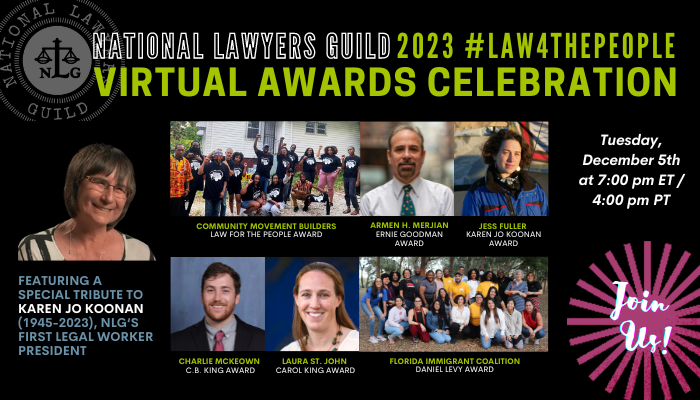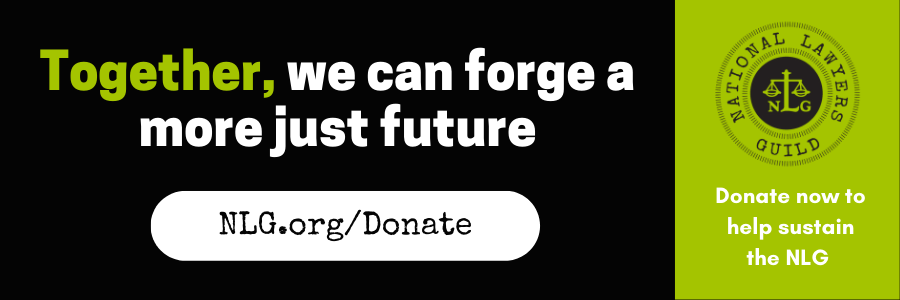FOR IMMEDIATE RELEASE
September 20, 2018
Contact:
Paul Stanley Holdorf, Esq.
Melinda R. Patterson, Esq.
908-591-1589 | plan@nlg.org
From August 21, 2018 to September 9, 2018, prisoners across the country participated in a peaceful strike to protest steadily deteriorating conditions of confinement in United States prisons. These worsening conditions, such as major cutbacks to prisoner programs, services, and safety measures have led to prison facilities that are increasingly dehumanizing and unsafe for prisoners. The April 2018 events at South Carolina’s Lee Correctional Institution, the deadliest prison incident in this country in the last 25 years, are emblematic of this sharp decline in prison conditions. Widespread reports from prisoners independently corroborated allegations that Lee Correctional prison guards turned their backs on the riot they provoked, while careful analysis of related media coverage suggests convincingly that the Department of Corrections implemented a sophisticated disinformation campaign that concealed facts from the public.
Unlike the 2016 prison strike, the 2018 strike was not only protesting the forced labor sanctioned by the 13th Amendment; it was also protesting nationwide cuts to important prison programs that many blame for the sharp uptick in prison slayings such as those at Lee, which have almost doubled in the last decade according to U.S. Bureau of Justice Statistics. Claims by correctional and political officials that these spending cuts are economically prudent overlook the millions of taxpayer dollars disbursed to pay sharply increasing wrongful death settlements, and undervalue the human lives entrusted to their care.
Using PLAN’s Legal Observer Affidavit for Prisoners and Jailhouse Lawyers, scores of prisoners from 12 states have reported prison abuses in lead-up to, and aftermath of, the 2018 prison strike, and additional reports continue to roll in. PLAN affidavits enable prisoners and jailhouse lawyers to document and report the prison abuses they observe or experience, and to transmit them to attorneys by way of unmonitored legal mail so that they can convey their concerns to legal professionals with less fear of reprisal. Before trying to connect these prisoners with legal response teams, PLAN enters the data from these affidavits into an anonymized database that tracks the facilities, states, and correctional systems generating the largest numbers of complaints and the kinds of abuses that are being reported with the greatest frequency. This enables PLAN to issue statements that are grounded in hard data.
In the first fortnight since the end of the strike, prisoners incarcerated in California, Florida, Georgia, Mississippi, Missouri, New York, North Carolina, Ohio, Pennsylvania, South Carolina, Texas, and Virginia have reported suffering prison abuses associated with their involvement (actual or perceived) in the 2018 prison strike. Among the initial findings and trends are the following:
- PRISON STAFF VIOLENCE AND OTHER RIGHTS VIOLATIONS. The strike-related affidavits received by PLAN do not dispute prisons’ implementation of policy-compliant disciplinary procedures for peaceful strike activities, such as refusing to work. The reports received allege prisoners’ rights violations, such as staff-perpetrated physical abuse, destruction of prisoners’ personal property, theft/destruction of prisoners’ legal property, and obstruction of prisoners’ access to administrative remedy procedures (e.g., withholding or refusing to process grievance forms). Rather than disciplining strikers in accordance with applicable policies and prisoners’ due process rights, there are widespread reports of rights-violating, and sometimes violent, crackdowns.
- ABUSES OF DISCRETIONARY AUTHORITY. The strike-related affidavits received by PLAN do not dispute prisons’ exercise of their discretionary authority to maintain secure and orderly operations. Instead, PLAN has received wide-ranging reports of prisons’ abuse of discretion:
- PRETENSE TO DEPRIVE PRISONERS ACCESS TO JAILHOUSE LAWYERS. There are compelling indications that numerous correctional systems have used prison strikes as pretense to retaliate against prisoners who exercise their rights under Johnson v. Avery 393 U.S. 483 (1969) to provide jailhouse lawyering services to other prisoners, and to prevent them from jailhouse lawyering by placing them into solitary confinement under false pretenses. For instance, one prisoner with a clean disciplinary record and no history of activism, who was a law library clerk on track for early parole, was segregated and transferred to a facility inaccessible to his family because he had in his possession a newsletter about changes to early release guidelines that happened to contain an article about the strike – a newsletter that the prison mail room had reviewed and deemed acceptable for delivery to him.
- PRE-EMPTIVE INSTEAD OF RESPONSIVE PRISON ACTION. There are also widespread reports of prison facilities targeting prisoner activists for segregation and transfer on the basis of anticipated (as opposed to actual) conduct. Thousands of prisoners nationwide were pre-emptively locked down and segregated for dates that corresponded to a national event, in the absence in many cases of any apparent indication that the prisoners were involved in that event. Segregating and transferring prisoners on the basis of presumed future behavior in the absence of evidence is arbitrary and capricious, and constitutes an abuse of discretion. When prison disciplinary and security actions become anticipatory instead of responsive, prisoners are deprived any semblance of due process rights.
- PRISON CRACKDOWNS INSIDE, DENIALS OUTSIDE. There is remarkable nationwide consistency in both reports of pre-emptive actions against prisoners in the period surrounding the 2018 prison strike, and also correctional systems’ talking points as cited in the media. At the same time that prisoners in twelve states from coast to coast were independently reporting heavy-handed pre-emptive crackdowns inside, prison systems in many of these states have staunchly refused to acknowledge prison strike activities in their facilities. For example, the Florida Department of Corrections was adamant in its statement regarding strike activity at Hamilton Correctional Annex that “[t]here is absolutely no indication that this incident occurred as a result of any national movement or organization.” In other jurisdictions, peaceful actions have been dubbed “riots” and “gang-related.” Independently corroborated prisoner reports spanning twelve states indicate that, while prison officials are meting out heavy-handed policy-violating abuses inside, they are characterizing peaceful demonstrations to the press as riot activity or “disturbances” unrelated to the strike.
- COMPELLING INDICATIONS OF NATIONAL COORDINATION OF PRISON TACTICS AND MEDIA STRATEGY. The nationwide consistency in prison tactics and media talking points related to the 2018 prison strike has drawn scrutiny to national correctional organizations, such as the American Correctional Association (ACA), which claims to independently accredit prison facilities’ adherence to national standards at the same time that it depends on those facilities for membership dues, lobbies on their behalf with legislative bodies, and convenes national trainings and networking sessions that may have contributed to the uniformity of prison responses to this year’s strike, without regard for the unique considerations of particular facilities. It is noteworthy that, following the 2016 national prison strike, the ACA delivered a national workshop on “Pivot Points” in correctional management strategies for “disturbances.” Using a number of prison “disturbances” as case studies, the ACA instructed prison officials from across the country on “preventing disturbances” and “managing external influences [the media].” The pre-emptive actions against thousands of prisoners without evidence or cause and the media disinformation campaigns implemented nationwide following the 2018 prison strike are consistent with the recommendations of this ACA strategy presentation following the 2016 prison strike.
- THE MEDIA AS THE ENEMY. A free press is a crucial underpinning of our society. When public officials exploit the media to propagate disinformation that is an ominous harbinger of a police state. Public servants are paid with public funds. They owe the public the truth even if (perhaps especially if) it does not cast them in a favorable light. In the ACA “Pivot Points” strategy session noted above, the media is cast as an “external influence” that prisons must “manag[e].” Prisons’ implementation of media disinformation campaigns was openly advocated in this ACA training session.
- ACA instructed correctional officials: “Providing the media with information…had the potential to incense the inmate population and reignite” disturbances. ACA stated that the lesson learned by the prison industrial complex was this: “The role of the media as participant in disturbances is [now] taken into consideration.”
- In relation to one prison case study cited in this national ACA presentation, correctional professionals were instructed: “[T]he media may have played a pivotal role in inciting inmates.”
Disturbing information is emerging about the role of ACA in forging and disseminating nationwide prison tactics and media strategies, and the degree to which these strategies extend “correctional management tactics” beyond prison walls to the general public. If the prison industrial complex perceives every media outlet and prisoner family member as an “external influence” whose access to information must be mitigated and controlled in order to “maintain secure and orderly operations,” then by that logic, prison officials owe the truth to no one.
WHAT CAN I DO TO HELP?
LEGAL PROFESSIONALS:
If you are an attorney, legal worker, or law student who would like to volunteer your time to support a PLAN legal response team responding to the aftermath of the 2018 prison strike, please contact plan@nlg.org.
FRIENDS AND FAMILIES OF PEOPLE INSIDE:
If you know of a prisoner who would like to communicate concerns about their conditions of confinement and request legal help, please download this form with instructions, and mail it to them inside Please note that PLAN does not litigate individual cases and that there may be some delay in replying. While we try to match prisoners in need with legal support, we cannot guarantee our ability to do so in every case.
# # #
The National Lawyers Guild, whose membership includes lawyers, legal workers, jailhouse lawyers, and law students, was formed in 1937 as the United States’ first racially-integrated bar association to advocate for the protection of constitutional, human and civil rights.



